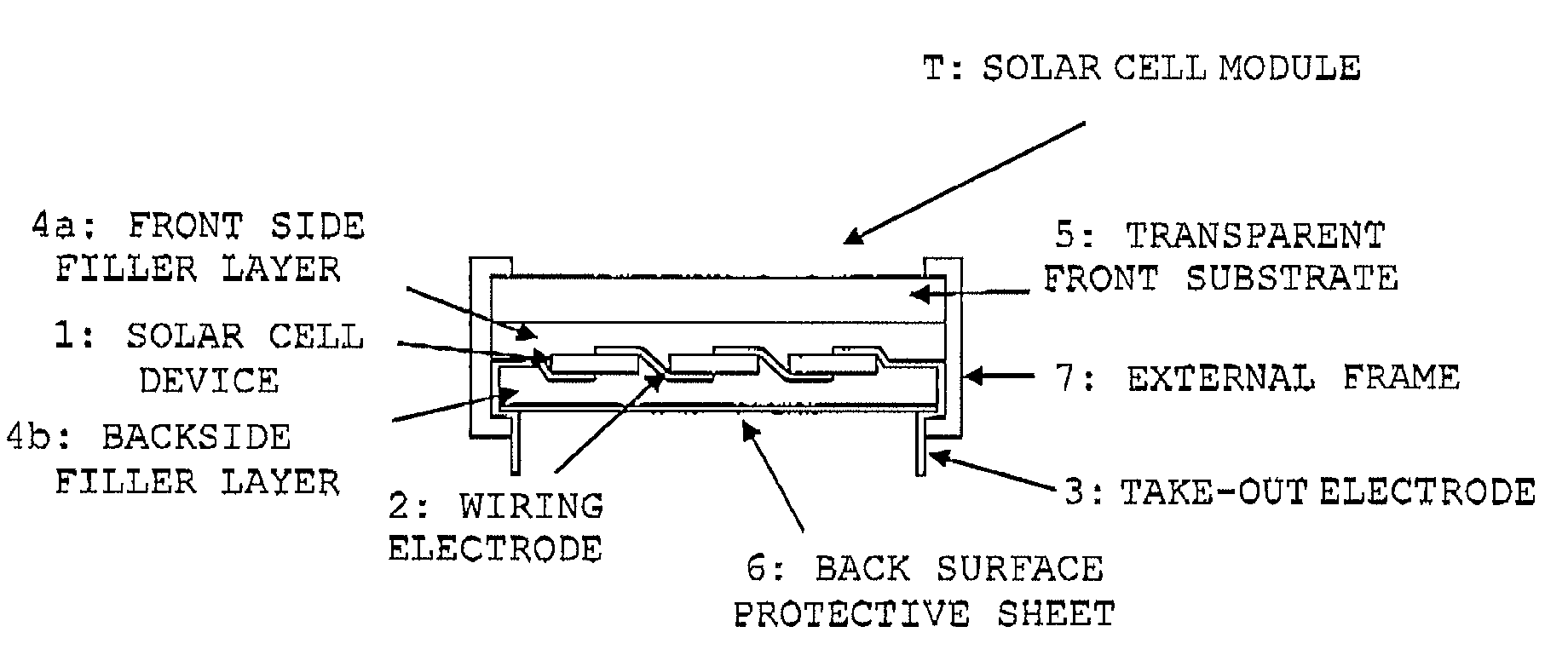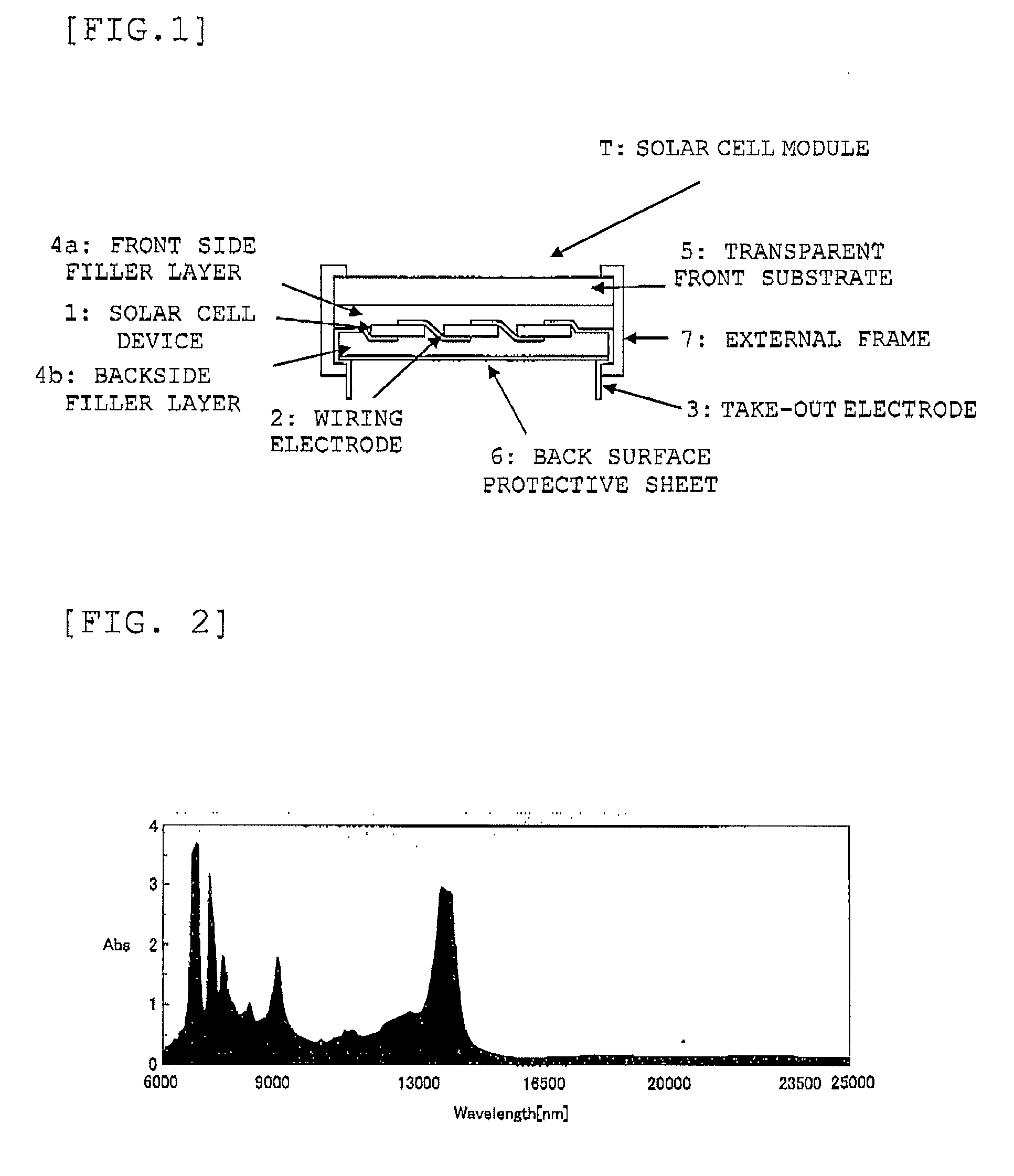Encapsulant for photovoltaic module, photovoltaic module using same and production method of photovoltaic module
a photovoltaic module and photovoltaic module technology, applied in the direction of photovoltaic energy generation, coatings, semiconductor devices, etc., can solve the problems of insufficient generation of electricity, weak physical impact of photovoltaic cell devices, and odor or foaming of photovoltaic cells
- Summary
- Abstract
- Description
- Claims
- Application Information
AI Technical Summary
Benefits of technology
Problems solved by technology
Method used
Image
Examples
example 1
(Preparation of Silane-Modified Resin)
[0113]In the beginning, to 100 parts by weight of metallocene based linear low density polyethylene having the density of 0.898 g / cm3, 2.5 parts by weight of vinyltrimethoxy silane and 0.1 part by weight of dicumyl peroxide as a radical initiator (reactive catalyst) were mixed, followed by melting and kneading at 200° C., thereby, a silane-modified resin was obtained.
(Preparation of Master Batch)
[0114]To 100 parts by weight of powder obtained by pulverizing metallocene linear low density polyethylene having the density of 0.900 g / cm3, 3.75 parts by weight of a benzotriazole based UV-absorbent, 5 parts by weight of a hindered amine based light stabilizer and 0.5 part by weight of phosphorus based thermal stabilizer were mixed, followed by melting and processing, thereby a pelletized master batch was obtained.
(Preparation of Encapsulant for Photovoltaic Module)
[0115]To 20 parts by weight of the silane-modified resin, 5 parts by weight of the maste...
example 3
(Preparation of Master Batch)
[0120]To 100 parts by weight of powder obtained by pulverizing metallocene linear low density polyethylene having the density of 0.896 g / cm3, 3.75 parts by weight of a benzotriazole based UV-absorbent, 2.5 parts by weight of a hindered amine based light stabilizer and 0.25 part by weight of phosphorus based thermal stabilizer were mixed, followed by melting and processing, thereby a pelletized master batch was obtained.
(Preparation of Encapsulant for Photovoltaic Module)
[0121]To 10 parts by weight of silane-modified resin used in example 1, 5 parts by weight of the master batch and 90 parts by weight of metallocene based linear low density polyethylene having the density of 0.900 g / cm3 as the polyethylene for addition were mixed and, according to a method similar to that of example 1, an encapsulant for photovoltaic module was prepared.
[0122]Furthermore, according to a method similar to that of Example 1, a photovoltaic module was prepared.
example 4
(Preparation of Silane-Modified Resin)
[0123]In the beginning, to 100 parts by weight of metallocene based linear low density polyethylene having the density of 0.896 g / cm3, 2.5 parts by weight of vinyltrimethoxy silane and 0.1 part by weight of dicumyl peroxide as a radical initiator (reactive catalyst) were mixed, followed by melting and kneading at 200° C., thereby, a silane-modified resin was obtained.
(Preparation of Master Batch)
[0124]To 100 parts by weight of powder obtained by pulverizing metallocene linear low density polyethylene having the density of 0.904 g / cm3, 1.88 parts by weight of a benzotriazole based UV-absorbent, 10 parts by weight of a hindered amine based light stabilizer and 0.5 part by weight of phosphorus based thermal stabilizer were mixed, followed by melting and processing, thereby a pelletized master batch was obtained.
(Preparation of Encapsulant for Photovoltaic Module)
[0125]To 20 parts by weight of the silane-modified resin, 5 parts by weight of the mast...
PUM
| Property | Measurement | Unit |
|---|---|---|
| density | aaaaa | aaaaa |
| thickness | aaaaa | aaaaa |
| thickness | aaaaa | aaaaa |
Abstract
Description
Claims
Application Information
 Login to View More
Login to View More - R&D
- Intellectual Property
- Life Sciences
- Materials
- Tech Scout
- Unparalleled Data Quality
- Higher Quality Content
- 60% Fewer Hallucinations
Browse by: Latest US Patents, China's latest patents, Technical Efficacy Thesaurus, Application Domain, Technology Topic, Popular Technical Reports.
© 2025 PatSnap. All rights reserved.Legal|Privacy policy|Modern Slavery Act Transparency Statement|Sitemap|About US| Contact US: help@patsnap.com


